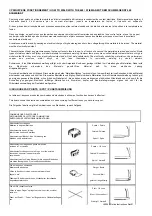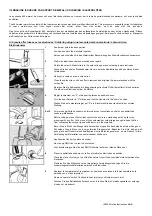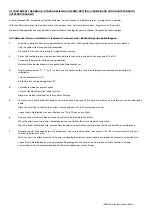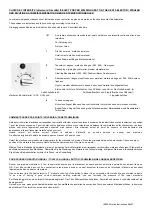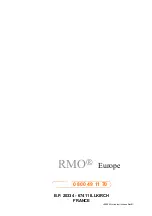
COMBINAISONS D’ELECTRODES
RECOMMENDED ELECTRODE COMBINATIONS
EMPFOHLENE ELEKTRODENKOMBINATIONEN
Attachements sur bagues
Matériau à bagues / Matrices
Attachments to bands, joining
plier-formed bands and matrices
Attachments auf Bänder - das Verbindung von
Matrizen und Bandmateriel
Attachements sur bagues de petite dimension
incisives inf. et canines
Attachements to bands too small to go over the pointed
electrodes, like small size anterior and
cuspid bands.
Attachments auf zu kleine Bänder, für die spitzen Elektroden,
wie kleine Bandgrößen, Front und Eckzanhnbänder.
Fils sur bague ou couronnes
Mainteneurs d’espaces
Wires to bands or crowns, space maintainers, fixed
linguals, etc.
Drähte auf Bänder oder Kronen, Lückenhalter, festsitzende
Lingualapparaturen etc.
Fils sur fils, ressorts sur arcs.
Wires to wires. “finger” springs to arch wires cribs, occlusal
rests, etc.
Draht auf Draht.... “Feder” auf Bogendrähte, Okklusalauflagen
etc
Pointe
Pointed / Pointed
Spitzf / Spitz
1/2 Lune
Pointed / Round Anvil
Spitz / Amboß
Gorge + Boule
Grooved / Ball
gefurcht / Kugelförmig
Plat + 1/2 Lune
Blunt / Grooved Anvil
Stumpf / Amboß
I/ PRINCIPE DE FONCTIONNEMENT / HOW TO WELD WITH THE 660 / WIE MAN MIT DEM SCHWEIßGERÄT 660
SCHWEISST
Pour souder par points, on utilise la propriété qu’à l’acier inoxydable d’être mauvais conducteur du courant électrique. Etant mauvais conducteur, il
s ’ é c h a u ffe quand il est parcouru par un courant électrique, jusqu’à sa température de fusion si l’intensité est suff i s a n t e .
Si deux pièces d’acier inoxydable sont pressées ensembles, elles resteront soudées à l’endroit où elles auront été portées à la température de
fusion.
Dans ce principe, on peut retenir que les parties à souder par point doivent être maintenues en pression l’une contre l’autre. et que l’on ne peut
souder par cette méthode que des métaux mauvais conducteurs et par conséquent aucun des métaux précieux qui sont tous d’excellents
conducteurs électriques.
A resistance weld is made by passing an electrical charge of high amperage and very low voltage through the materials to be joined. The material
must be electrically resistant.
The combination of heat and pressure causes the two surfaces to fuse into one. In a fraction of a second, the materials are joined and cooled. Mosts
types of stainless steel and Elgiloy
®
are ideal materials for resistance welding. However there are some so-called stainless steels that are so high in
nickel content that they are not as electrically resistant and will not weld satisfactorily. The electrically conductive materials such as aluminium,
copper
and
precious
metal
alloys,
do
not
lend
themselves
to
resistance
welding
by
dental
welders.
Schweissen : Eine Widerstandsschweißung erfolgt, mit hoher Amperezahl und sehr geringer Voltzahl zur Verbindung des Materialien. Dabei wird
die
Elektrische
widerstand
des
Materials
genutzt. Das
Material
muß
für
diese
elektrische
Ladung
strapazierfähig sein.
Durch die Kombination aus Hitze und Druck werden die beide “Metalloberflächen” verschmolzen. In einem Bruchteil von Sekunden wird das Material
miteinander verbunden und kühlt ab. Die meisten Edelstähle und Elgiloy-Draht sind ideale Materialien für die Widerstandsschweißung. Jedoch gibt
es einige sogennante Edelstähle, mit sehr hohem Nickelanteil ; diese haben einen niedrigenren elektrischen Widerstand und sind somit für die
Schweißung ungeeignet. Elektrisch leitfähige Materialien wie Aluminium, kupfer und Edelmetallegierungen eignen sich nicht für die
Widerstandsschweißung bei Dentalschweißgeräten.
II/ SOUDURE PAR POINTS / SPOT / PUNKTSCHWEIßUNG
Le tableau ci-dessous montre les combinaisons d’électrodes à utiliser en fonction des travaux à effectuer.
This board shows the electrodes combinations to use according to different tasks you have to carry out.
Die Folgende Tabelle zeigt die Kombinationen von Elektroden, je nach Aufgabe.
J00064 Notice Instructions Rev01


